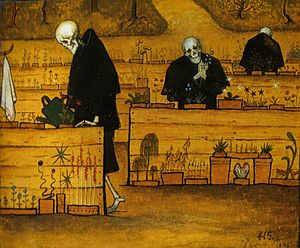In the garden of death

|
| In the garden of death |
|---|
| Hugo Simberg , 1896 |
| Watercolor and gouache |
| 15.8 x 17.5 cm |
| Finnish National Gallery in the Ateneum , Helsinki |
In the Garden of Death , Finnish "Kuoleman puutarha" , is a watercolor by the Finnish painter Hugo Simberg , which was created in 1896. It belongs to the collection of the Finnish National Gallery and is located in the Ateneum , Helsinki. The theme of the paper is the impartiality of death, which is depicted as the helper and guardian of the human soul.
Image content
The sheet, which is just 15.8 by 17.5 centimeters, shows three skeletons clad in dark coats, standing between raised beds and devoting themselves to the care of the flowers and trees. Death, represented here by these three figures, does not show itself as a brutal reaper, but as a gentle godfather of death. Hugo Simberg uses motifs from the fairy tale story of a mother by Hans Christian Andersen . Every flower and every tree represents a human life, which death is attentively cared for and which is transplanted into paradise after the death of the human being. The figure on the left carefully pours the plants entrusted to him, and on the right of the center of the picture, one of the figures carefully presses one of the flowers to his chest with bony hands.
Classification in the complete work
The theme of the garden of death can be found several times in Hugo Simberg's work. The best-known representation is probably the fresco in Tampere Cathedral , which Hugo Simberg painted in 1905 and 1906. It differs from the watercolor only by a different color scheme. The personified death and the “poor devil” are motifs that are often found in Hugo Simberg's work. The representations are often macabre and show supernatural scenes. These works include "Death listens" (Finnish: Kuolema kuuntelee ), in which Death, dressed in black, bows his head to listen to a young man playing the violin. In the background, an old woman is lying on the bed, looking pale and sickly. The picture gives the viewer the impression that death has come to fetch her, but that he has decided to wait a moment longer to let the young man finish playing the violin.
supporting documents
literature
- Sabine Schulze (Ed.): Gardens: Order - Inspiration - Luck , Städel Museum , Frankfurt am Main & Hatje Cantz Verlag, Ostfildern 2006, ISBN 978-3-7757-1870-7 .
Single receipts
- ↑ US website for In the Garden of Death , accessed January 3, 2010
- ↑ Sabine Schulze (Ed.): Gardens: Order - Inspiration - Luck , Städel Museum , Frankfurt am Main & Hatje Cantz Verlag, Ostfildern 2006, ISBN 978-3-7757-1870-7 , p. 154
